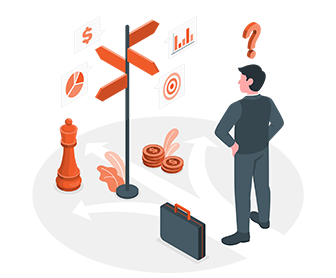It's a common problem that jewelry companies don't know when to time their software upgrade or implementation. Which period of the year is the best to start such a project? You will find the answer in this blog post.
Awareness phase
Many jewelry companies come to the realization of the need for change during a busy holiday season because this season magnifies existing issues. As a result, the need for change suddenly becomes urgent.

But let's step back a bit in the story. Why don't jewelry companies take action when they have a relatively calm period and more time to think about getting a new management system? One reason is that when things are quiet in the company, some problems remain hidden. If you don't do something efficiently, it easily goes unnoticed:
We had enough time, we did it, we checked it off the list.
At this point, no one thinks about how to improve that inefficient process. This is still the phase when we can't see the forest for the trees.
Most companies reach a point where the change cannot wait because circumstances choke the company. For instance, online orders become unmanageable, too many orders create chaos, and too much management time is spent on things that should work on their own.
If it makes you feel better, this situation is also common outside of the jewelry industry. For small and medium-sized companies, reaching the awareness phase tends to be slower.
Decision making
 Making decisions, especially at this caliber, is not easy. During this journey, you must make different decisions at different levels. The first and most important decision is when you finally decide to seek a system that could solve your efficiency problems.
Making decisions, especially at this caliber, is not easy. During this journey, you must make different decisions at different levels. The first and most important decision is when you finally decide to seek a system that could solve your efficiency problems.
The second decision is which one to choose from the many possibilities. Unknowingly, you find yourself in a complex situation because no system does exactly what you need. Some may come close but are more expensive.
How should I decide? Based on features, price, support, or further support? Obviously, all of these are important, but how should I prioritize these decision factors?
Once you've made your choice of software, the last major decision will be when to start the implementation and who is the most suitable person within the company to lead this implementation.
The best time to start implementing your jewelry ERP
We often encounter unrealistic expectations when it comes to ERP implementation. An ERP system performs sophisticated tasks, automates and simplifies processes, but the road to this can be complex.
It's definitely worth taking a step back and looking at the project with a realistic eye. When do we want to start using the new system in live mode? Let's consider a few factors:
- Can this be sustained even if we agreed with the vendor on some custom development to be done during this period?
- Can this be sustained if we add requirements to the scope during the implementation project?
- Can this be sustained if the project manager cannot focus consistently on the project for an extended period? Is there a chance that we will have to temporarily take the project manager out of the project to help with preparations for a trade show or the peak season?
- Can this original timeline be sustained even if the summer vacation period or the holiday season arrives?
The challenge with very tight deadlines is that numerous external and internal factors can interfere. Delays can happen due to various unfavorable factors, with both the vendor and the client sometimes facing difficulties in delivering on time. While responsibility is shared, these delays could lead to stress and unnecessary pressure.
The best advice we can give you is to add a buffer period to your calculations. That’s the way to set up a realistic go-live target date.
Here's what it might look like in practice:
- Let's say the estimated configuration time is 6 months.
- The first month after the sales phase is not for actual configuration work but rather for establishing the project's correct scope and an in-depth business analysis, based on which the implementation will be planned.
- The last few months: configuration is completed, but a few critical weeks remain for user training or the soft go-live. During this time, potential issues may arise that need to be addressed.
- So, the 6-month period is only 6 months in an ideal scenario, but you need to add the buffer periods mentioned above.

The illustration shows how you should proceed correctly. If you want to start using the system in October, before the high season, it will not be enough to make the decision in April or May. Make the decision in February so that by March, the PIRO team and you have completed the Business analysis (BA) and defined the initial scope.
This presumes that the actual work configuration work can be started by the end of March or early April. By September, the configuration will be ready, followed by user training and a soft go-live (a brief monitoring period). By this time, you'll have your current data imported, you start entering live orders, and any last-minute issues are fixed.
By October, you can confidently use your new system.
Life after the Go-live
The period after the go-live can still be hectic, as this is when you may discover, despite extensive testing, a few things that might not work as planned in practice. However, most situations can be rectified with minor adjustments. Users may not yet feel entirely confident about using the system during this time. They may misuse the system, input data in the wrong places, or appear slow because they're not yet accustomed to their new tasks.
Settlement phase
One to two months is typically sufficient for the company to adapt to the new routines. Some benefits may become visible a few months after the go-live, and the effort put into implementation will gradually be paid off.
Change is always painful. I know from my own experience how much I disliked it when my favorite online portal switched to a new platform, and everything felt unfamiliar. Simply, I couldn't find the articles that interested me. My subconscious kept telling me that the old version was better.
The key takeaway
We hope you found this article useful and are confident in embarking on a project together with us. At PIRO, we work based on accumulated experiences, trying to rectify past mistakes that caused issues in previous projects.
Buffer periods are a real thing – that’s how we experienced it. From an implementation point of view, these are necessary stages and indirectly contribute to the success of the implementation. The key takeaway is to plan your project carefully. If you include the buffer periods, there will be no surprises at the end.





